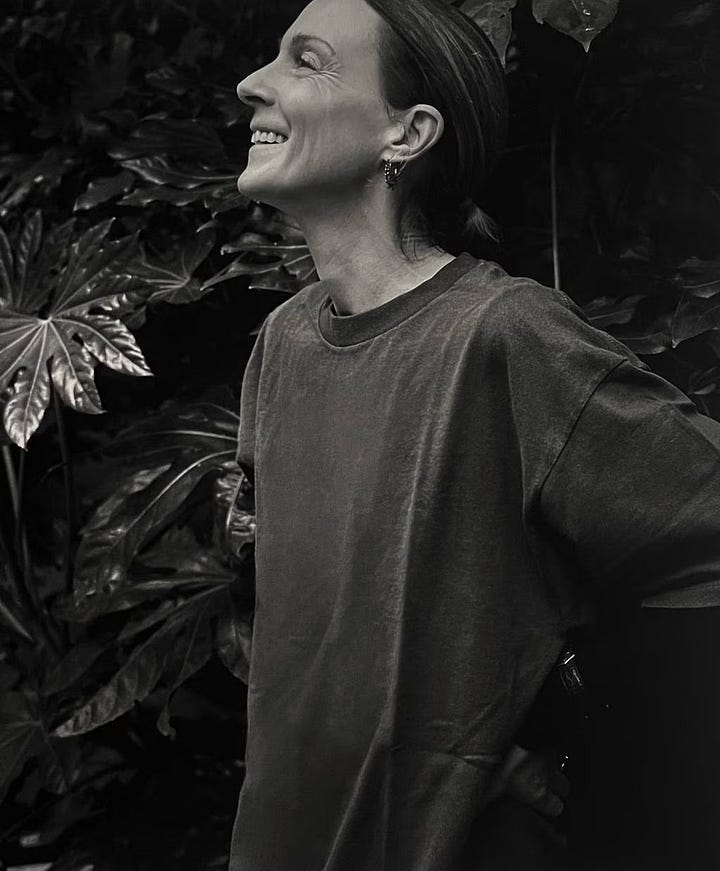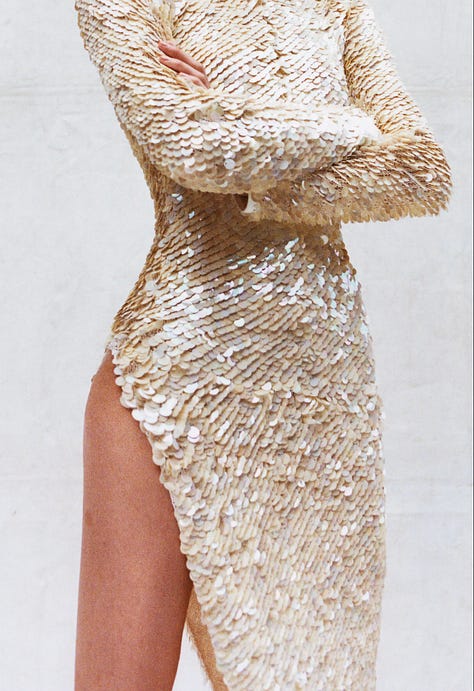Phoebe Philo is back, but what's the impact?
Sexy, aspirational, on design point. So let's see how the year's most anticipated brand launch is doing on sustainability.
Hello! This is It’s Not Sustainable, a community of fashion lovers who care about the planet. If you enjoy these posts, please join us and become a paid subscriber, it’s £1.50 a week. Then you will be helping push the agenda forward and will be invited to exclusive events, intimate gatherings - and a coffee with me. You can see the different plans here:
Be still our beating hearts and our bank balances, at last Phoebe is back - and so much to love! It only dropped an hour ago (at time of writing) and already it’s selling out. I’m getting panic-y thinking I should be buying something. That high neck rib jumper in Melange Brown, but it’s £1500? Oh sh*t, it’s sold out. The MUM necklace in gold has gone - what about those zip trousers, I mean, how sexy? But I can’t try them on and I need to feel the fit. I’m dithering while all the squares turn red. Quick, get it before it goes! It’s like being on the home page of Shein. Since I promised myself something from this collection as one of my five buys this year, let’s do a quick principles check.
Firstly - the broader cultural shift. No make up. Minimal jewellery (no multiple perforated ear candy). Daria Werbowy, (Philo’s long term muse) is back, older and rawer. In a world of false eyelashes and filters, I love all of this. Daria Werbowy looks just like Phoebe herself: honest, worn, plain and all the more beautiful for it.


There’s no size diversity, so you need to be in shape. There’s a lot of carping about this online, but not all designers need to be inclusive to everyone. This is not a volume driven brand, it is a tribal aesthetic. It’s the designer’s right to create that aesthetic and ours to make choices about how we ally ourselves. The collection is wearable but it’s far from boring - there are moments of flamboyance in a palette of cream, tobacco and black. It’s also a bit punk: confrontational, just how we like it.






Philo’s woman, born first at Chloé, then grew up at Céline, has never made any apologies. There’s elevated tailoring for the boardroom and a fluoro red cocktail dress for the dance floor, (although Philo’s woman could probably interchange both outfits and get away with it). This time she also knows the streets - the jewellery is proper hardware; a MUM necklace and a weaponised toothpick pendant give some edge. Some Portobello in the 90s. And then there’s the sex appeal. Women who grew up with Phoebe are having sex, and it’s better than ever. That’s seen, with trousers that unzip up the arse cheek, deep toe cleavage and thigh high slits. Amazing.
It’s true that since she left the fashion stage, there are many who have picked up where she left off: The Row, Khaite, Victoria Beckham, even Cos and Frankie Shop. Note that all these brands are designed by women, and is it any wonder women flock to their own? In an industry with such a startling lack of creative diversity, backing the leaders that really understand the customers - who FEEL them, who SEE them, who LIVE them, is not unsmart. This collection puts Philo right back in the game, and a quick Whatsapp survey suggests my fellow Philo-philes think so too. We love the collection, if not the prices. But luxury is increasingly becoming a spectator sport.
So, how is she scoring on sustainability? To be honest with you, I’m disappointed we don’t know more. The bare website plastered with super cool imagery doesn’t have much in the way of immersive storytelling - but it does have an impact tab, which delivers a short statement. Great that impact has gone into consideration, and as Philo is building this from the ground up, with a 49% investment from LVMH, she really has no excuse. My dream was that Philo, with her massive influence, was going to show luxury what sustainability, transparent supply chains, fair labour and future fashion looks like. Has she done that?
Firstly and most obviously, she is going to sell everything she makes: there are 150 styles sold directly to customers (no wholesale) and produced in numbers “notably less than anticipated want”, as the impact statement reads. This is intended to create “a responsible balance between production and demand.” No waste then and carefully managed growth. Some might call this scarcity marketing, others might call it responsible. I also heard through the grapevine that Philo was looking for new designers to whom she could donate excess materials, thus finding a home for cutting room floor excess and helping foster a new generation of talent. If this is the case, what an excellent model.
The descriptions of each garment are disappointingly minimal, so there’s no knowing if jacket linings are polyester (petro chemical derived synthetics) or viscose (MMCFs). The latter one would hope, considering the prices.
Knitwear core materials are listed as merino wool and cashmere, with a gangsta coat in shaved shearling. Jackets are cotton drill, wool twill and leather. All these are biodegradeable, natural materials and in designs you expect to last forever. Judging by the way her old Céline pieces still do a brisk trade, these are certainly long term, if not forever pieces. Have these materials been sourced from regenerative farms? How far have they travelled across the globe? Who picked them, wove them, dyed them? How were they dyed?
There’s also a liberal use of viscose and a silk viscose mix. Viscose is a man made cellulosic fabric (MMCF) which allows for creative versatility, usually derived from FSC certified trees, although the process of turning it into fabric is chemical and energy intensive. Disappointingly, there’s a high-neck sweatshirt in ‘double-face chenille technical polyester’. Polyester is landfill enemy, plus she has also used some petrochemical elastene for stretch in her silk satins. A heavily sequinned dress also features - you can get sequins made of biomaterials (Phoebe’s old friend Stella uses them), but most times they are made of plastic. No further clarity supplied.
Bags and shoes are suede and leather. Leather can be made with varying degrees of ethics - it’s not just animal rights but the tanning process which is heavy on chemicals, energy and water which needs to be assessed. Jewellery is sterling silver, gold and gold plated, with no clue as to whether it is recycled or single mine origin. It should be recycled, in which case it’s weird that this is not stated.
Another clue comes in the form of a fashion tech company we are working with in Ibiza at our AGORA store to supply block chain enabled supply chain transparency.
Paying subscribers can continue to read the post below. If you would like to upgrade and commit to this community, (and I would love to have you) you can upgrade here:






